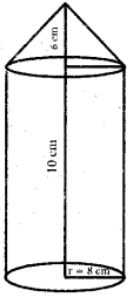Total surface area = C.S.A. of the cone + C.S.A. of cylinder + C.S.A of the hemisphere.

Cone:
Radius (r) = 8 cm
Height (h) = 6 cm
Slant height l = \(\sqrt{r^2+h^2}\)
= \(\sqrt{8^2+6^2}\)
= \(\sqrt{64+36}\)
= √100
= 10 cm
C.S.A. = πrl
= 22/7 × 8 × 10
= \(\frac{1760}{7}\) cm2
Cylinder:
Radius (r) = 8 cm;
Height (h) = 10 cm
C.S.A. = 2πrh
= 2 × \(\frac{22}{7}\) × 8 × 10
= \(\frac{3520}{7}\) cm2
Hemisphere:
Radius (r) = 8 cm
C.S.A. = 2πr2
= 2 × \(\frac{22}{7}\) × 8 × 8
= \(\frac{2816}{7}\) cm2
∴ Total surface area of the given solid
= \(\frac{1760}{7}\) + \(\frac{3520}{7}\) + \(\frac{2816}{7}\)
T.S.A. = \(\frac{8096}{7}\) = 1156.57 cm2.